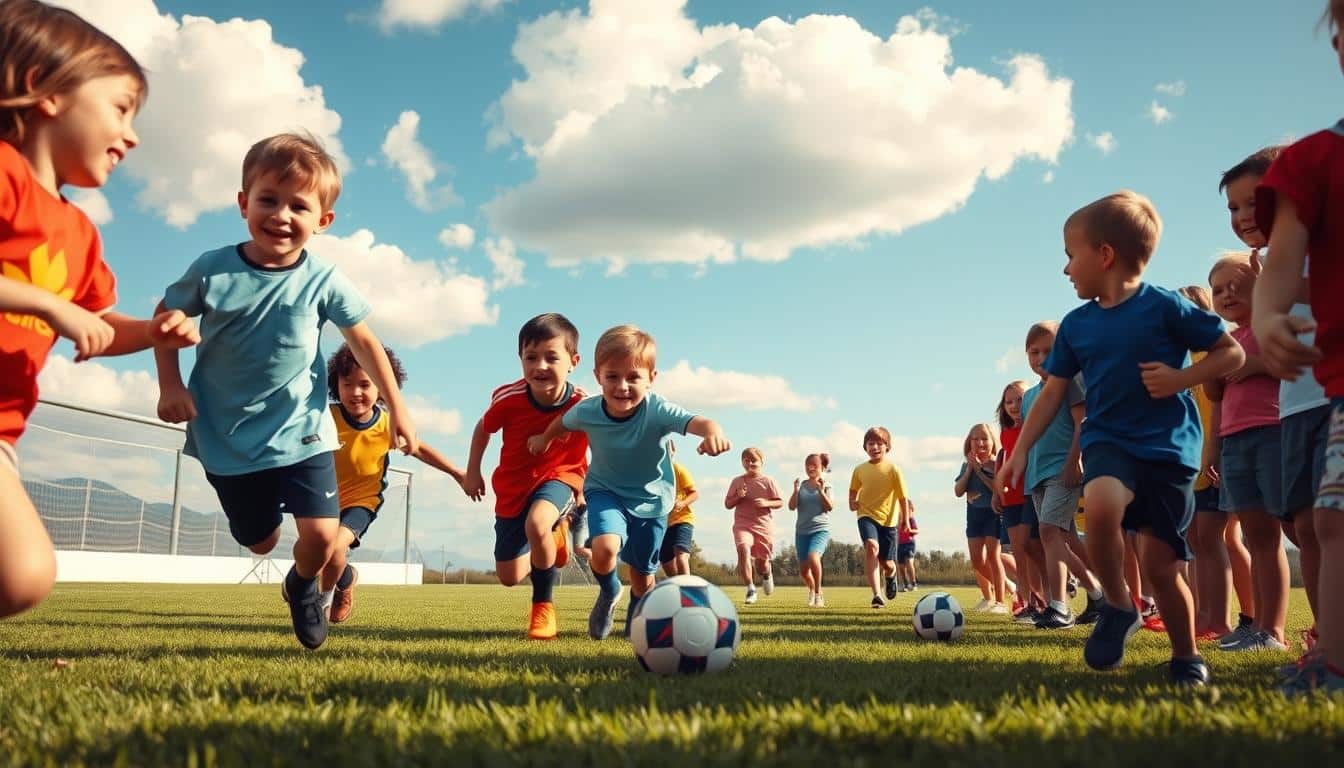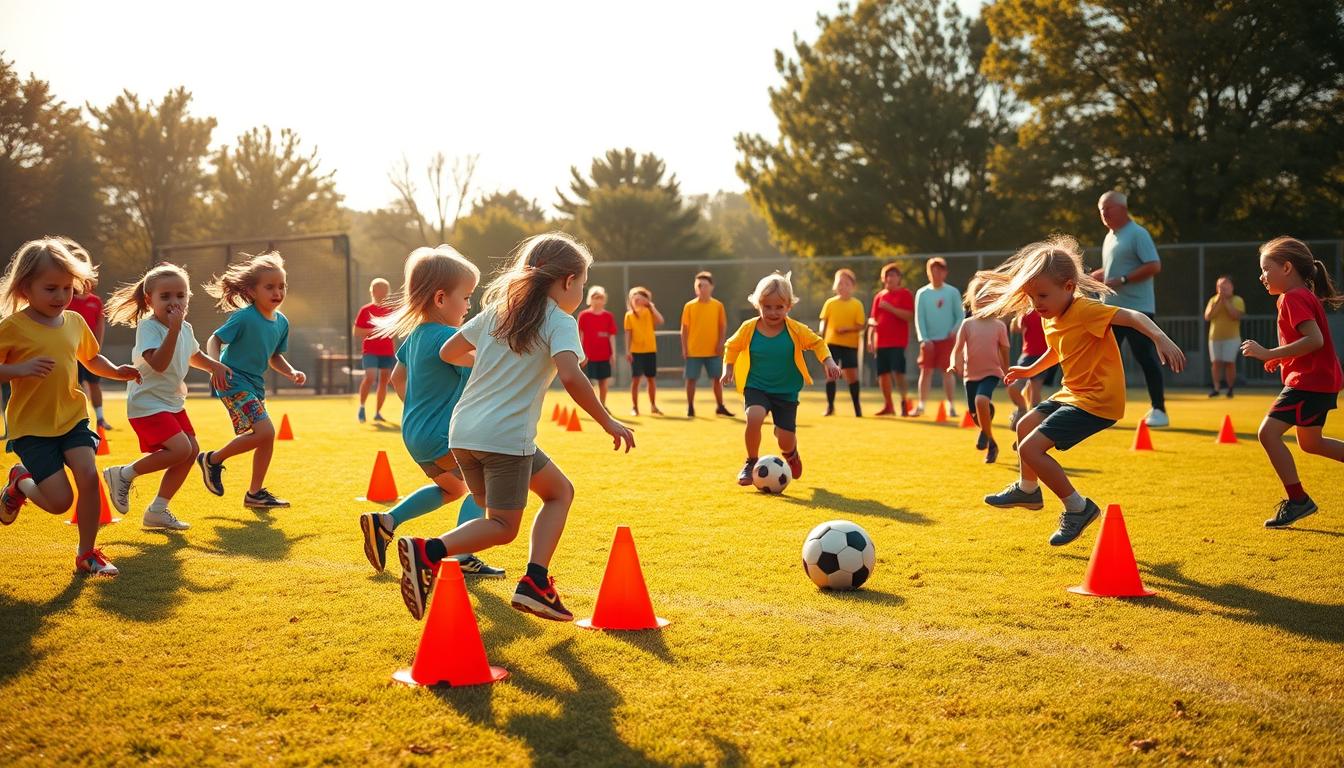How to Organize Soccer Relay Races for Kids | Fun Drills

Looking for a way to make youth sports more engaging while sharpening essential skills? Soccer relay races blend fast-paced action with teamwork, turning practice into playtime. Whether you’re coaching beginners or refining advanced techniques, these drills keep players moving, laughing, and learning.
Simple setups work best. Use cones to mark lines, assign small groups, and focus on core moves like dribbling or passing. Coaches from Soccer Coach Weekly found that structured relays improve footwork and endurance faster than traditional drills. Kids stay motivated because it feels like a game, not a lesson.
Clear instructions are key. Avoid confusion by demonstrating each step first. Split your squad into even teams, and let the energy flow as players race to tag the next teammate. You’ll see confidence grow with every sprint.
Key Takeaways
- Relay races boost teamwork and technical skills in a high-energy format.
- Short, focused drills keep young athletes engaged and eager to participate.
- Visual demonstrations prevent misunderstandings during fast-paced games.
- Balanced groups ensure fair competition and maximum involvement.
- Endurance improves naturally through repeated sprints and ball control challenges.
Planning Your Relay Race Event
Successful youth sports activities start with smart preparation. Choose a flat, open space free of obstacles – grassy fields or gym floors work best. Measure the area to fit at least three parallel lanes, each marked by cones spaced 10 feet apart.
Identifying Your Venue and Equipment
Safety comes first. Inspect the surface for holes or debris. Use brightly colored cones to create clear boundaries and turning points. You’ll need one ball per team – size 3 or 4 works for younger players.
Check all equipment before starting. Deflated balls or unstable cones can disrupt the flow. Arrange a central supply station for quick access during drills.
Setting Goals for the Day
Define what you want players to achieve. Focus on one core skill per session, like passing accuracy or dribbling speed. Split groups into even teams based on skill levels to keep games fair.
Explain rules using visual demonstrations. Show how the next player line works – athletes wait behind a marked cone until tagged. This structure keeps the game moving while reinforcing spatial awareness.
End with a quick equipment checklist: cones, balls, and a whistle for coaching signals. Proper planning means more time for laughter and less for troubleshooting.
Soccer relay races for kids: Setting Up the Field
The key to smooth-running drills lies in meticulous setup. Start by choosing a flat area free of rocks or debris. Measure three parallel lanes, each 10 meters long, using a tape measure or stride count for accuracy.
Marking Boundaries and Safety Zones
Place bright cones every 3 meters along each lane’s edges. This creates visible paths and prevents collisions. For turns, position a final cone 2 meters beyond the finish line – this gives players space to pivot safely.
| Team Size | Cones per Lane | Ball Size |
|---|---|---|
| 3-5 players | 4 | 3 (ages 6-9) |
| 5-8 players | 6 | 4 (ages 10+) |
Balancing Groups and Gear
Divide athletes into equal teams based on skill levels. Assign one ball per group, placing it at the starting cone. Use colored pinnies if available to help players identify teammates quickly.
Double-check all lanes match in length and cone spacing. Uneven setups create unfair advantages. A structured layout keeps the game flowing and lets coaches focus on skill development instead of fixing errors.
Fun Drill Ideas and Game Variations
Spice up practice sessions with drills that feel more like play than work. These creative twists on classic activities keep energy high while building coordination and communication. Rotate through different challenges weekly to maintain enthusiasm.

Dribbling Relay Basics
Start with a simple zigzag course using 5-7 cones spaced 3 yards apart. Players weave through the pattern while keeping the ball close. This sharpens quick direction changes and builds confidence in tight spaces.
Add excitement by timing each round or letting teams choose their path. For younger athletes, use larger cones and slower speeds. Progress to smaller markers as skills improve.
Passing Combination Challenges
Set up two parallel lines of teammates 10 yards apart. The first player passes to their partner, then sprints to the end of the opposite line. Receivers control the ball before returning it. This drill teaches accurate strikes and movement off the ball.
Boost difficulty by requiring one-touch passes or adding a goal target at the end. Teams earn bonus points for hitting specific zones. You’ll see better spatial awareness and crisper exchanges within weeks.
- Shark Attack: Defenders try to steal balls mid-dribble
- Musical Cones: Remove markers between rounds
- Backward Dribbles: Reverse the usual path
Team Strategies and Safety Considerations
Effective team dynamics start with smart grouping and clear roles. Mix athletes of varying skill levels to create balanced squads – this prevents lopsided scores and keeps everyone invested. Soccer Coach Weekly recommends using colored pinnies for instant team identification and rotating captains to build leadership skills.
Organizing Groups for Success
Place experienced participants first and last in line to stabilize the drill’s rhythm. Newer players thrive in middle positions where they can observe peers before their turn. Always designate a next player zone 3 feet behind the start line to avoid collisions.
| Strategy | Benefit | Implementation |
|---|---|---|
| Skill-Based Pairing | Balanced competition | Assign 1 advanced + 2 intermediate + 1 novice per team |
| Rotational Order | Equal participation | Shift lineup positions after each round |
| Captain Roles | Leadership development | Let players call encouragement signals |
Safety First, Always
Scan the field for hidden hazards like sprinkler heads or wet patches before starting. Maintain 8-foot gaps between lanes during high-energy fun drills for younger athletes. Key safety steps:
- Require shin guards during contact drills
- Use foam balls for indoor training sessions
- Position coaches midway along lanes to monitor collisions
End each session with a hydration break and skill recap. This reinforces learning while letting bodies cool down gradually. Structured teamwork paired with vigilant supervision creates an environment where strategy and safety grow together.
Relay Games to Build Endurance and Skill
Transform practice sessions into skill-building marathons with drills that push physical limits while refining technique. These activities merge continuous movement with precise ball control, creating double wins for athletic development.
Dribbling Courses with Mini Goals
Set up a 30-yard lane with 5 cones spaced 5 yards apart. Place a mini net at the end line. Players dribble through the pattern, shoot into the goal, then sprint back to tag the next teammate. This drill builds:
- Stamina through repeated sprints
- Close ball control under fatigue
- Finishing accuracy under pressure
Adjust difficulty by widening cone gaps for advanced groups or requiring weak-foot-only dribbles. Time each round and display scores to fuel friendly competition.
Diagonal Pass Drills for Precision
Create two parallel lines 15 yards apart at a 45-degree angle. The first player passes diagonally to their partner, then follows the ball to join the opposite line. Key coaching points:
- Weight passes to land near receivers’ dominant foot
- Encourage one-touch returns for speed
- Use both instep and outside foot techniques
Increase challenge by adding a moving defender or requiring first-time shots after receiving. This sharpens spatial awareness and player coordination during high-intensity sequences.
Always finish with a cool-down lap and skill shoutouts. Structured training games teach athletes to perform technical moves even when tired – a critical edge in real matches.
Bringing It All Together for a Successful Event
Creating unforgettable youth sports moments starts with smart preparation and energetic execution. Combine your field setup expertise with creative drill ideas to build an event where every player grows while having fun.
Review your equipment checklist: cones marking clear lanes, properly inflated balls, and safe spacing between teams. Balance groups by skill level to keep competition fair yet challenging. Rotate drill variations weekly – zigzag dribbles one day, precision passing games the next.
Final safety checks matter. Scan for hidden hazards, confirm shin guard use, and position coaches to monitor action. Celebrate progress by ending with high-fives and specific skill shoutouts.
Remember: great training blends structure with spontaneity. Adjust lane lengths or team sizes based on your group’s energy. When drills feel like play, athletes naturally develop sharper footwork and stronger teamwork.
Now grab those cones, gather your squads, and let the laughter begin. With clear coaching and this action plan, you’re ready to create experiences where every participant leaves sweaty, smiling, and eager for the next session.
